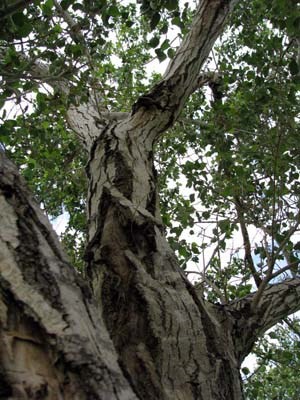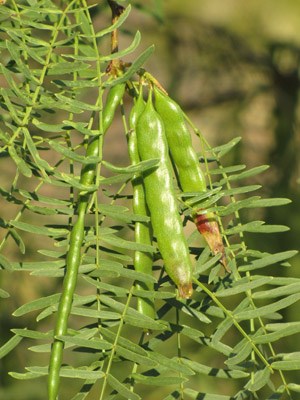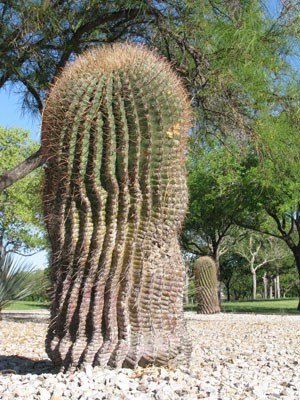|
The Chihuahuan Desert is one of four major deserts located in North America (Mojave, Sonoran, Great Basin and Chihuahuan). It covers over 175,000 sq miles - more than twice the size of Florida. Most other deserts in this hemisphere have formed due to the "rain shadow" effect where precious, life-sustaining rain and snow empty only on one side of a mountain range leaving the other dry and parched. Our desert, however, lies in an inland corridor where moist, tropical air from the south cools and drops its moisture on mountain tops known as "sky islands". These pockets of moisture sustain a diverse community rich in plant and animal life. No other desert boasts such diversity. Here, in the El Paso region, we find a large community of small leafed and mostly thorny plants such as creosote, tarbush, and acacias. Chamizal National Memorial is home to some of the Chihuahuan Desert's more common plant species. 
Cottonwood (Populus sp.) "Remember the Alamo!" Texans cried. Did you know that alamo is the Spanish word for cottonwood? Chamizal National Memorial and the surrounding area actually have two species of native cottonwoods: the Rio Grande cottonwood (Populus deltoides) and the Fremont cottonwood (Populus fremontii). All cottonwoods grow where water is abundant, such as near natural springs, along the banks of the Rio Grande, in dried creek-beds where the water table lies just below the surface, and where humans water the tree, like at Chamizal National Memorial. But humans need water as well. The Rio Grande has been dammed in several spots and since the vast majority of the river's water is now used by people, the Rio Grande is meager. As the Rio Grande's riparian ecosystem has deteriorated, riverside cottonwoods have deteriorated as well. 
Desert Willow (Chilopsis linearis) The desert willow is a highly specialized desert plant that adds a splash of color to the El Paso landscape. The thin, waxy leaves protect the tree from losing too much moisture in this arid climate. The tree will drop leaves in times of drought and will remain dormant until the next rain. American Indians used the leaves of the desert willow for baskets and the bark for shirts and nets. The orchid-like flowers were used to treat coughs. The wood was used for fuel and building material. 
Honey Mesquite (Prosopis gladulosa) If you like to barbeque, then the word mesquite may ring a bell. Mesquite is an ingredient found in many barbeque briquettes, and its smoke gives your steak or baby back ribs a distinct flavor. The honey mesquite is native to the U.S.–Mexico border region and is a relatively small tree. It releases nitrogen into the soil. Nitrogen maintains soil health and is a prerequisite for farmers in maintaining soil fertility. A member of the legume family, wild animals eat the bean pods that are produced by the honey mesquite. 
Mondell Pine (Pinus eldarica) A native tree of the Middle East, the Mondell pine, also known as the Afghan pine, is especially well suited for living in hot, dry places like El Paso. It can withstand long periods of drought, grows well in full sun, can endure constantly heavy winds, is generally resistant to pests, and it is not invasive like many other nonnative species of plants. The Mondell pine is commonly used as a wind breaker and city beautifier. This is the only coniferous (needle and cone bearing) tree within the memorial. 
Live Oak (Quercus virginiana) Most oak trees are deciduous, which means that they lose their leaves every fall. But the live oak keeps its leaves year-round—it's an evergreen. This type of oak is relatively small in size and can often be low-growing like a bush. The live oak does not require much water and can grow in poor soils. The acorns produced are a staple food source for the urban wildlife of Chamizal National Memorial—birds and squirrels. Past hunter and gatherer societies ground the acorns into flour. The leaves were used as bedding, or were burned to ashes and used as a cleaning agent similar to lye. The pulverized bark was dusted on open sores to aid healing and would often be used to treat newborns with bleeding navels. The bark was also boiled and used as a dye for buckskins. Even the branches were woven into work baskets as handles or used as a structural support. Today, live oaks shade us from the summer sun and beautify our cities. Oak wood is used to make kitchen and dining room tables, as well as bedroom furniture. 
Palo Verde (Parkinsonia aculeata) In Mexico, it is known as lluvia de oro, which is Spanish for "gold rain." Indeed, the Mexican palo verde produces bright yellow flowers from April to August. The palo verde is a small tree, rarely growing above 20 feet high. Its branches are green and twig-like, hence the name palo verde (green stick). Native to the U.S.–Mexico borderland and especially common in the Sonoran Desert of Arizona, the Mexican palo verde grows naturally in desert washes. Because it does not require much water and can live in full sun, the city of El Paso has planted these trees in many of park around town. Be careful when observing the palo verde--its camouflaged thorns are insensitive to human skin. 
Four-Wing Saltbush (Atriplex canescens) A small tract of land just west of the memorial was known as El Chamizal because the chamiza was a common shrub in the area. It is from this plant that Chamizal National Memorial gets it name. The four-wing saltbush, or chamiza, is a hearty shrub with prickly leaves. The plant thrives in salty soils. Tiny hairs on the chamisa's leaves conserve water. Indigenous people used the leaves as a seasoning, mixed the leaves with other greens to eat much like spinach, and ground the seeds for meal. This shrub is common in the area surrounding El Paso and a few have been planted at the memorial. 
Barrel Cactus (Ferocactus wislizenii) Appropriately named, the barrel cactus survives long periods of drought by storing water inside its sponge-like barrel. The large pleats in its trunk allow it to expand like an accordion as it absorbs precious moisture. The root system, located near the ground surface, enables rapid absorption of rainfall. The waxy coated channels of the stem protect against evaporation and direct water like irrigation canals towards the roots during times of drought. The barrel cactus produces yellow flowers in April and May. The flowers eventually turn into an edible fruit that American Indians harvested and stored as a food source. The needles were used for sewing, body piercing, and as fish hooks. Unfortunately, barrel cacti are no longer common in the surrounding desert due to poachers harvesting them for area gardens. 
Lechuguilla (Agave lechuguilla) You know you are in the Chihuahuan Desert when you see this plant. It can be easily spotted from your car as you drive about the area.The lechuguilla, or shin dagger, has a shallow root system that enables it to drink up rainwater. All parts of this plant were harvested by American Indians. It was a source of fiber for weaving baskets and floor mats and used to make brooms and brushes. The sharp tips were used as needles for binding animal hides. The roots were used for soap, and the fruit was consumed during times of famine. This plant is appropriately named—shin dagger—as its thorns are extremely sharp! 
Century Plant (Agave americana) The century plant has a shallow but vast root system that allows it to take in more water than would be possible with a long taproot. The stems of the century plant funnel water to its center where it needs water most. For most of its life, the plant does not bloom. However, once in its lifetime, which is approximately 10 to 15 years long (not a century), the century plant produces a tall stalk. The stalk can grow up to 14 feet high, and it produces white flowers. After the stalk blooms, the plant dies. But death is all part of nature's cycle: the decaying plant gives nutrients to the soil and another century plant will grow in its place. Also known as American aloe, the century plant was used by American Indians as a source of food, medicine, and even soap. Just like in pre-colonial times, the artichoke-like heart is harvested today just before the blossom emerges, which happens only once in its long life cycle. Its pit is then roasted and eaten. The root bulb, which holds the plant's lifetime supply of sugar, is often left to dry in the sun to ferment and then be consumed as a beverage. The plant's fibers are used for making rope and pot scrubbers. The roots, fresh or dried, makes a useful soap. 
Desert Spoon (Dasylirion wheeleiri) Desert spoon is often mistaken for a yucca. Its short and thick central stem is the base for numerous long, thin, flat, bluish-green leaves. These leaves have a spoon shaped base, hence the common name Desert Spoon. Leaf edges are armed with prominent sharp hooks. American Indians used the leaves for weaving baskets and sleeping mats. Flowers emerge from the spike that shoots up from the base. The plant must store energy for years before it can produce a stalk with tiny cream-white blossoms. These rounded clumps resemble coarse grass from a distance. The flower stalks were eaten as greens, were boiled, or cooked by burying them in ashes. People also roasted the heart of the plant in pits and ate them. More recently, the heart has been fermented to produce a liquor called Sotol. 
False Yucca (Hesperaloe parviflora) Also called False Aloe, this plant was used as a soap because of the natural saponin found in the roots. Indigenous people would make a tea from the pounded, dried roots for treating kidneys. Some would chew the roots as a cure for intestinal parasites or diarrhea. The colorful blossoms are a favorite food for moths, butterflies, bees and hummingbirds. 
Ocotillo (Fourquieria splendens) For at least two-thirds of the year, the ocotillo remains patiently dormant with its tall stems reaching for the sky. This highly specialized plant will produce leaves and flowers only when moisture is present and then drop them during drought. The thorny, skeletal-framed stem continues to produce energy for the plant through photosynthesis even when leaves are not present. In April, bright red flowers bloom on the tip of the stems, just in time for the thousands of hummingbirds that migrate through the area. Stems can root quickly from cuttings, so it is not uncommon to find ranches using them as a "living fence". Whether alive or dormant, enjoy the ocotillo from a distance—its thorns are unforgiving! Southwestern natives would gather its seeds and blossoms. Seeds were toasted, then ground into flour and used to make cakes. Fresh blossoms were eagerly harvested by children who would pick the flowers and suck its nectar. A sweet delicacy was made by squeezing the nectar out of the blossoms and allowing it to dry into a hardened rock candy. The blossoms were also used to make a refreshing drink by soaking the flowers in water. 
Prickly Pear (Opuntia sp.) The prickly pear cactus stores water in its pads for use during the dry season. Animals, such as the javelina (a.k.a collared peccary), chew on these pads regularly.In times of drought, area ranchers singed the pads to remove the prickles and then fed them to their livestock. Ranchers also used the gooey insides as a dressing for open wounds on injured livestock. In April, prickly pear cacti produce flowers in a range of colors from yellow to pink. The cactus produces fruit in the spring and summer. Prickly pear cactus juice is used to make special candy and honey, while the pads (nopales) are sold in the produce section of grocery stores. |
Last updated: February 11, 2025
